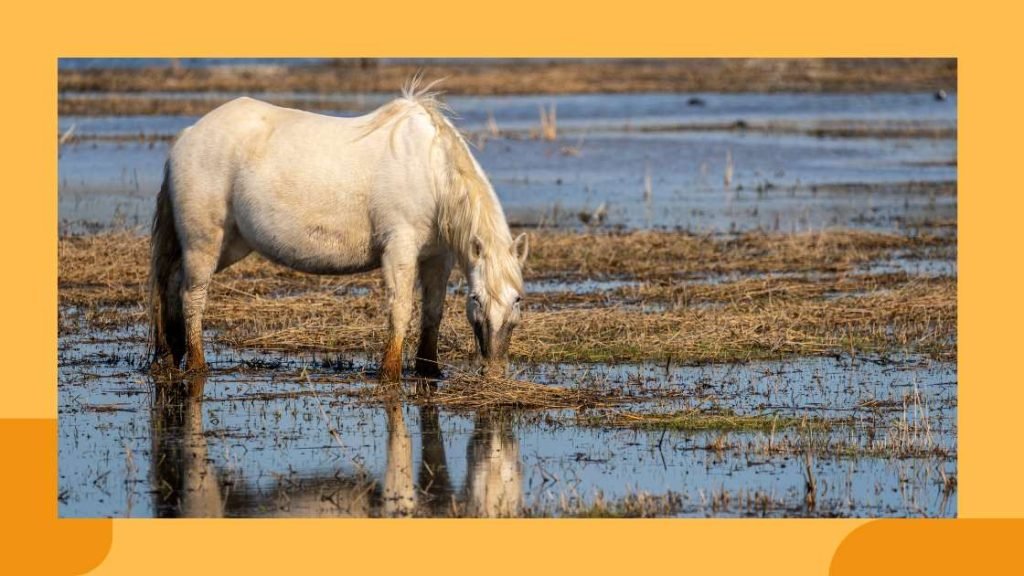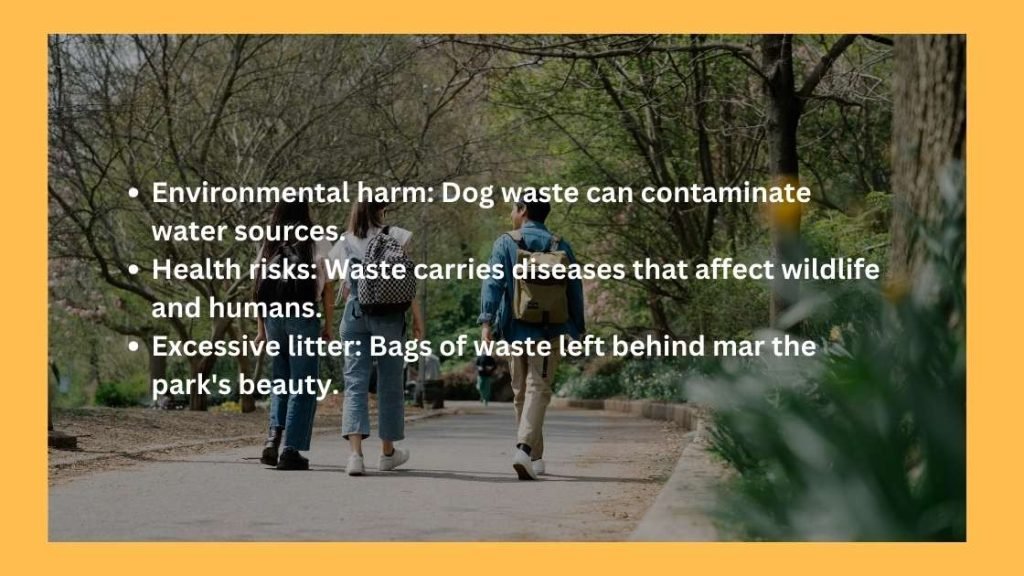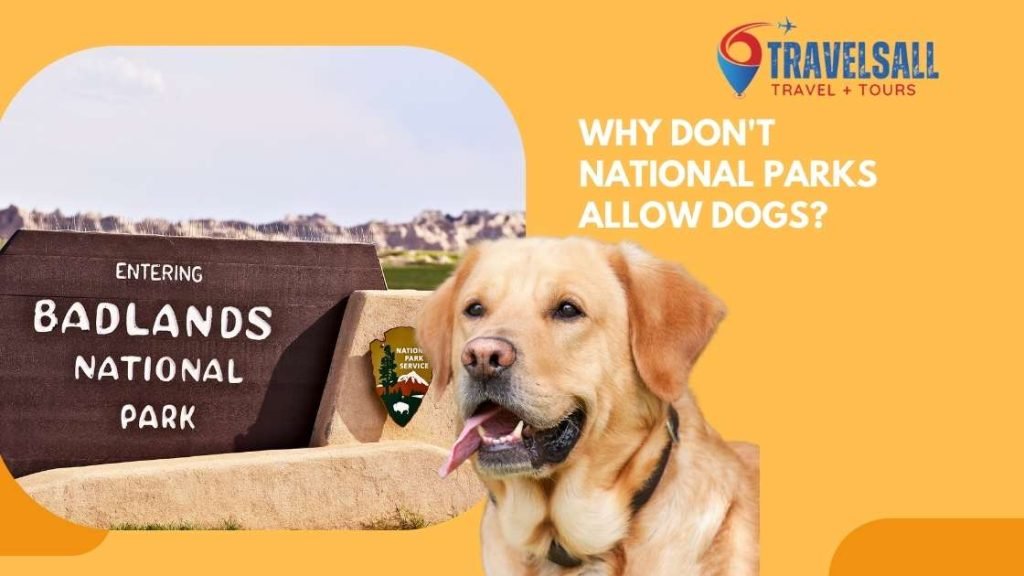National parks often restrict dogs to protect wildlife and preserve the natural ecosystem. Canines can disturb animals and introduce diseases to wild populations.
National parks are like safe homes for animals and plants. They keep the balance in nature. But, when dogs visit, even if they are very well-behaved. They can make things go a little crazy.
Just the smell of dogs can stress out the animals. This might change how they eat, have babies, and travel around. So, dogs should stay out of national parks to keep everything in harmony.
Dogs can sometimes hurt other animals and plants in nature, which is not good. Also, when dogs go to the bathroom outside, it can make the land and water dirty.
So, in some places like parks, there are rules to keep animals, people, and beautiful nature safe. Even though pet owners might not like these rules, they help take care of the environment and keep everything in balance.
Now let’s explain “Why Don’t National Parks Allow Dogs?”
Table of Contents
ToggleWildlife Preservation Efforts

National Parks are bastions of nature, aiming to preserve the wilderness for generations. These lands offer a sanctuary for diverse ecosystems and a retreat for wildlife away from human disturbances.
A key aspect of these conservation efforts is minimizing disruptions to the habitat, especially from domestic pets like dogs.
Alongside safety concerns, the core reason parks impose restrictions is to maintain the delicate balance of the area’s flora and fauna. Let’s Investigate the rationale behind these policies.
Protecting Natural Behaviors
National parks serve as a haven for wildlife, allowing animals to live according to their natural behaviors.
The presence of dogs can trigger stress and anxiety in wildlife, altering their natural behavior patterns.
If birds in a park see a dog as a danger, they might leave their nests, and then they can’t have baby birds. Parks want to make sure animals can find food, have babies, and move around freely, so they try to keep dogs away.
- Dogs can chase or scare wildlife
- Nesting animals are particularly vulnerable
- Stress on wildlife can lead to negative impacts on their health
Minimizing Human Impact
Parks prioritize a minimal human footprint to maintain pristine environments. Dogs, by nature, mark territory, dig, and potentially disrupt the landscape.
They may inadvertently introduce diseases or parasites foreign to the park’s ecosystem, which can spread swiftly among the native wildlife.
Through the absence of dogs, parks control human-related impacts that can compromise natural habitats.
| Potential Impact | Reason to Exclude Dogs |
|---|---|
| Soil erosion from digging | Maintain landscape integrity |
| Spread of non-native species | Protect local flora and fauna |
| Disturbance to wildlife | Encourage natural ecosystem balance |
Ultimately, policies restricting dogs from national parks stem from the goal of preserving the untouched state of the wilderness, reducing disturbances to wildlife, and safeguarding the park’s ecological health.
Safety Concerns For Visitors

Safety Concerns for Visitors often top the list when discussing restrictions in national parks. National parks focus on providing a secure environment for everyone who visits.
Yet, dogs can introduce unpredictable elements that raise safety issues. To ensure a safe experience for all, parks set rules that sometimes mean leaving our four-legged friends at home.
Potential Aggressive Encounters
Wildlife in national parks is often unaccustomed to domestic animals like dogs. This can lead to stressful encounters for both wildlife and pets.
Dogs may exhibit unpredictable behavior when facing unfamiliar animals or situations, elevating the potential for harm.
Aggressive confrontations could occur, posing a risk to the dog, its owner, and the park’s wildlife.
Preventing Dog-related Accidents
Accidents often occur without warning, and the presence of dogs could increase this likelihood. With distinctions in terrain and large crowds, dogs may inadvertently cause tripping hazards or become startled, leading to bites or falls.
By excluding dogs, national parks strive to diminish these risks, creating a safer visit for everyone.
- Protect visitors from unexpected dog reactions.
- Maintain distance from potentially dangerous wildlife.
- Reduce the number of trip-and-fall incidents.
Disease Control Measures
National parks safeguard the delicate balance of nature. A hidden risk to this balance often walks on four legs: dogs.
Dogs may seem harmless, but they can be disease carriers, posing a serious threat to park ecosystems. Let’s investigate why disease control measures are necessary to protect these natural sanctuaries.
Preventing Disease Transmission
Allowing dogs into national parks could mean the introduction of new diseases. These diseases can spread rapidly.
They can affect native animals who have no immunity to them. Parks have measures to keep their inhabitants healthy.
These measures include not allowing dogs. This is both for the safety of your furry friend and for the park’s residents.
- Distemper and parvovirus can jump from dogs to wildlife.
- Microbes on paws and fur might disrupt local habitats.
- No vaccination guarantees. Some visitors might have unvaccinated dogs.
Wildlife Health Risks
Wild animals face enough challenges. Disease shouldn’t be one of them. Dogs can unknowingly carry pathogens harmful to wildlife. Parks act as sanctuaries for these wild animals. Limiting potential threats, like dogs, helps in preservation efforts.
Concerns include:
| Disease | Source | Impact on Wildlife |
|---|---|---|
| Canine distemper | Dog to wild mammal | Fatal to several species |
| Heartworm | Mosquito from an infected dog | Affects wolves and foxes |
| Parasites | Dog feces | Harms soil and water quality |
These steps ensure the longevity of diverse ecosystems. The well-being of all park residents remains a top priority.
Protecting Canine Visitors

Many nature enthusiasts ask, why aren’t dogs allowed in national parks? The answer lies in safety. Not only wildlife and ecosystems but our beloved pets need protection too. Keeping dogs out ensures their well-being amidst the wild.
Natural Hazards For Dogs
National parks pose risks for our furry friends. From rugged terrain to toxic plants, dogs can fall prey to many dangers.
- Predator encounters can be deadly for pets.
- Dogs may find and consume harmful fauna.
- Extreme weather conditions can lead to injury or distress.
- Unfamiliar wild territories have invisible hazards that are not pet-friendly.
Stress From Wilderness Exposure
Wild landscapes are far removed from a dog’s daily environment. Such exposure can stress them emotionally.
| Cause of Stress | Effect on Dogs |
|---|---|
| New scents and sounds | Anxiety or overexcitement |
| Lack of familiar resources | Discomfort and potential dehydration |
| Sudden encounters with wildlife | Fearful reactions or risky confrontations |
By keeping dogs out, national parks help protect them from these potentially traumatic experiences.
Environmental Impact
National parks serve as sanctuaries for wildlife and ecosystems. Dogs have an undeniable impact on these protected environments.
Ecosystem Disruption By Dogs
Dogs are natural predators. Their presence alone can stress wildlife. Animals change their behavior. They spend more energy hiding or fleeing, impacting their survival.
- Dogs chase, hunt, or scare wildlife
- Native animals risk their young and nests
- Predatory behaviors disturb natural balances
Not just predators, dogs can be hosts. They carry non-native species, including seeds or insects. These species may become invasive. This shifts the native ecosystem.
Trail And Vegetation Damage
Dogs can unintentionally harm trails and surrounding vegetation. Trails face erosion with extra use. The risk increases with dogs on the loose.
| Type of Impact | Effects |
|---|---|
| Physical Trail Damage | Paths widen, plants die, soil compacts |
| Vegetation Death | Plants trampled, root systems broken |
Dog waste contributes to the problem. It adds nutrients to soil unnaturally. This favors certain plants over others, harming diversity.
Dogs can disrupt the tender balance of national park ecosystems. Park rules aim to protect these areas. Rules ensure all species thrive together for generations.
Regulatory Reasons
Regulatory Reasons behind national parks not allowing dogs are vital for park management. These rules keep wildlife and landscapes safe. They also help visitors enjoy nature without disturbance.
Legal Framework For National Parks
National parks operate under strict laws. These laws protect native fauna and flora. The legal framework sets the rules for all visitors.
- Preservation Acts: Laws like the Endangered Species Act protect wildlife from potential threats.
- Public Use Regulations: These dictate what activities are suitable within park boundaries.
- Resource Protection Laws: Aim to conserve natural resources for future generations.
Enforcement Of Park Rules
Park staff ensure rules are followed. This helps maintain the parks’ integrity and visitor experience.
- Patrols: Rangers patrol regularly to enforce rules.
- Education: Visitors learn about the importance of following guidelines.
- Penalties: Fines or expulsion can result from breaking park rules.
Dogs are not allowed to keep these unique ecosystems intact and ensure enjoyable visits for all.
Keeping Parks Pristine

Imagine walking through a national park, where nature flourishes, unperturbed. National parks showcase Earth’s beauty, undisturbed by human influence.
Dogs, as much as we love them, can disrupt this balance. They bring certain challenges that park authorities work hard to prevent. Let’s Investigate why these furry friends are often left at home.
Litter And Waste Concerns
Dogs have natural needs, and sometimes, their waste becomes a problem. Each dog’s visit may seem insignificant, but with millions of visitors, the impact adds up. Let’s dig into the effects:
- Environmental harm: Dog waste can contaminate water sources.
- Health risks: Waste carries diseases that affect wildlife and humans.
- Excessive litter: Bags of waste left behind mar the park’s beauty.
Preserving Natural Aesthetics
National parks treasure the raw allure of nature. Dogs can unknowingly damage this:
- Eroding trails: Their paws can wear down paths faster than human feet.
- Disturbing wildlife: Dogs might chase animals, disrupting habitats.
- Altering ecosystems: The scent of a dog can scare off essential species.
Cultural And Historical Significance
National parks are more than just nature reserves. They protect the landscapes that hold our history. Stories of the past whisper through their trees and grounds.
By respecting these sites, we keep history alive. Keeping dogs out of national parks helps protect these sacred places.
Respecting Sacred Sites
Many national parks were once areas of worship or burial grounds for indigenous communities. These sacred sites require the utmost respect.
Dogs, by their nature, can disturb these areas. They might unknowingly damage artifacts or ceremonial grounds. So, the parks ask visitors to leave their furry friends at home.
This shows respect for cultures that consider these lands holy.
The Role Of Parks In Heritage Preservation
National parks serve as guardians of our heritage. They house historical structures and landscapes vital to our story as a nation.
To ensure these tales live on, park regulations limit activities that could harm these areas. This includes restricting pet access. Such rules safeguard the integrity of our historical treasures for future generations.
Alternative Options For Dog Owners
Beyond national parks, dog owners seek pet-friendly adventures. Investigate why national parks restrict dogs. Discover fun alternatives to enjoy outdoors with furry friends.
National parks prioritize wildlife safety and habitat preservation. Dogs can disturb wildlife and natural ecosystems. Alternatives provide balance for environmental concerns and pet-friendly outings.
This section guides dog owners to tail-wagging destinations.
Dog-friendly Park Areas
Some parks offer dedicated areas for dogs. These are both enjoyable and respectful of park rules. Dog-friendly zones often include:
- Off-leash areas for free play
- Trails where leashed dogs can walk with their owners
- Picnic spots for the whole family, dogs included
Research park rules online or call ahead. Always check guidelines before visiting to ensure a stress-free experience.
Responsible Dog Tourism
Hold responsible dog tourism. This keeps destinations welcoming for dogs in the future. Follow these simple steps:
- Use leashes when required for control and safety.
- Ensure your dog is well-behaved around crowds and wildlife.
- Clean up after your pet to keep areas pristine.
Dog owners can promote positive practices in pet-friendly locations. This supports the community and furthers pet inclusion.
Frequently Asked Questions For Why Don’t National Parks Allow Dogs
Why Are There No Dogs In National Parks?
Dogs are typically not allowed in national parks to protect wildlife and their habitats and to ensure visitor safety and enjoyment.
Can I Bring My Dog To US National Parks?
Yes, you can bring your dog to many US national parks, but rules vary by park. Check specific park regulations and always keep dogs on a leash.
Why Are Dogs Not Allowed On California Trails?
Dogs are often restricted on California trails to protect wildlife and their habitats. These rules also minimize trail conflicts and prevent the spreading of canine-borne diseases to native species.
Can I Take My Dog Into Yellowstone National Park?
Yes, you can take your dog to Yellowstone National Park, but pets must stay within 100 feet of roads, parking areas, and campgrounds. Always keep them on a leash no longer than 6 feet. Pets are not allowed on trails or in the backcountry.
Conclusion
The restrictions on dogs in national parks safeguard wildlife and ecosystems. Such policies are vital for conservation and safety. Despite the inconvenience to pet owners, these rules ensure that national parks remain pristine for all visitors.
Remember, respectful exploration preserves nature’s wonders for generations to come.



